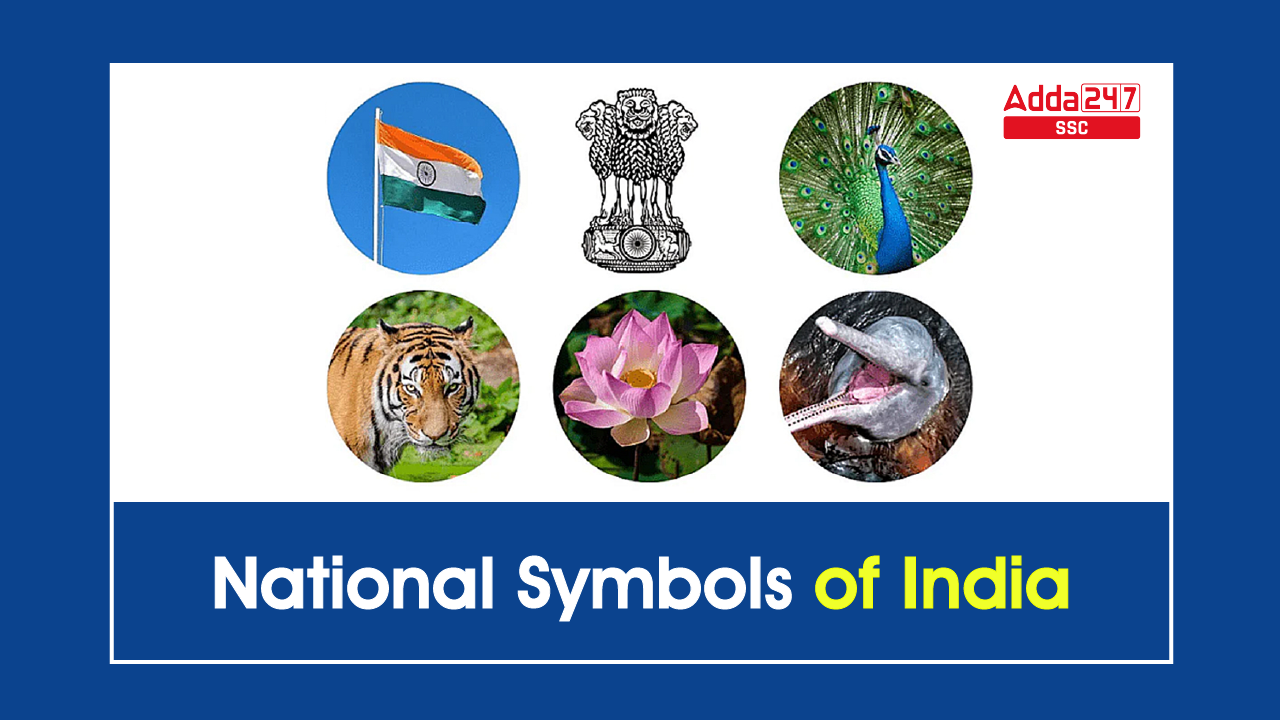National Symbols of India
National symbols of India: The national symbols of India encompass a variety of elements that collectively craft a distinctive portrayal of our nation’s values and ethics. These symbols hold intrinsic significance to the Indian cultural fabric and historical legacy. Each of these national symbols evokes a deep sense of pride and patriotism within every Indian individual. These emblems have been selected over different periods, with careful consideration, and each embodies a specific virtue that represents a distinct characteristic of the country. Explore the comprehensive compilation of India’s national symbols along with additional insights about them.
National Symbols of India: Check Complete List
India has 17 national symbols namely Tiranga, Jana Gana Mana, Saka Calendar, Vande Mataram, National Emblem of India, Mango, Ganga, Royal Bengal Tiger, Indian Banyan, Ganges River Dolphin, Indian Peacock, Indian Rupee, King Cobra, Indian Elephant, Lotus, Pumpkin and National Pledge. Here is the list of the National Symbols of India. Read the detailed article for more information.
| S. No. | Title | National Symbols |
|---|---|---|
| 1 | National Flag | Tiranga |
| 2 | National Anthem | Jana Gana Mana |
| 3 | National Calendar | Saka calendar |
| 4 | National Song | Vande Mataram |
| 5 | National Emblem | National Emblem of India |
| 6 | National Fruit | Mango |
| 7 | National River | Ganga |
| 8 | National Animal | Royal Bengal Tiger |
| 9 | National Tree | Indian Banyan |
| 10 | National Aquatic Animal | Ganges River Dolphin |
| 11 | National Bird | Indian Peacock |
| 12 | National Currency | Indian Rupee |
| 13 | National Reptile | King Cobra |
| 14 | National Heritage Animal | Indian Elephant |
| 15 | National Flower | Lotus |
| 16 | National Vegetable | Pumpkin |
| 17 | Oath of Allegiance | National Pledge |
Importance of 17 National Symbols of India
17 National Symbols are discussed below. These symbols represent a quality unique to India and its citizens. These help to preserve the chosen national symbol for generations to come. The national symbols of India will Infuse a deep sense of pride in the hearts of Indian citizens.
National Flag
Tiranga or Tricolour is the national flag of India. It is a horizontal tricolor of India saffron (Kesari) at the top, white in the middle, and India green at the bottom in equal proportion. The chakra in the middle has a diameter approximately the width of the white band and it has 24 spokes. The ratio of the width of the flag to its length is 2:3. The National flag was designed by Pingali Venkayya and was adopted by the Constituent Assembly on 22nd July 1947.
National Anthem
The National Anthem of India is Jana-Gana-Mana. The anthem was first sung on 27 December 1911 at the then-Calcutta Session of the Indian National Congress. It was composed originally in Bengali by Rabindranath Tagore. Jana-Gana-Mana was adopted by the Constituent Assembly as the National Anthem of India on 24 January 1950. The entire song consists of five stanzas. The first stanza of the complete song contains the full version of the National Anthem. The playing time of the national anthem is approximately 52 seconds.
National Song
The song Vande Mataram, composed in Sanskrit by Bankimchandra Chatterji, is the National song of India. It was declared the National Song of India on 24 Jan 1950. The First President of India, Dr. Rajendra Prasad came up with a statement in the Constituent Assembly, “the song Vande Mataram, which has played a historic part in the struggle for Indian freedom, shall be honored equally with Jana Gana Mana and shall have equal status with it.” The first political occasion when Vande Mataram was sung was the 1896 session of the Indian National Congress.
National Emblem
The national emblem of India is adopted from the Lion Capital of Ashoka at Sarnath. In the national emblem, four lions are standing back to back, mounted on an abacus with a frieze carrying sculptures in high relief of an elephant, a galloping horse, a bull, and a lion separated by intervening wheels over a bell-shaped lotus. The motto of the national emblem is Satyameva Jayate.
National Bird
The Indian peacock, scientifically known as Pavo cristatus, holds the esteemed position of being India’s National Bird. This avian creature exhibits a vibrant and captivating appearance, resembling a swan in size. Adorned with a captivating fan-shaped array of feathers on its crest, it features a distinctive white patch beneath its eye and boasts of a slender, elongated neck. Peacock is majorly found in the drier lowland areas and is a resident breeder in the Indian subcontinent. It was declared the national bird of India on February 1, 1963.
National Animal
The Royal Bengal Tiger is the national animal of India. It was adopted as the national animal of India in April 1973 due to the receding population of tigers. The scientific name of this striped animal is Panthera tigris. It is characterized by its thick golden-yellow coat of fur with dark stripes. India is home to nearly half of the total population of tigers in the world.
National Symbols of India in Hindi
National Flower
The National Flower of India is Lotus (Nelumbo Nucifera Gaertn). In India Lotus is a legendary flower and much folklore and religious mythology is woven around it. Lotus is an aquatic herb that is often termed as ‘Padma’ in Sanskrit and enjoys a sacred status in the Indian culture.
National Calendar
The Saka Era is the National Calendar in India. It was adopted as the national calendar on 22nd March 1957. This calendar starts on 22 March and consists of 12 months or 365 days just like a normal year. In a leap year, the starting day is 21 March.
National Aquatic Animal
The Ganges river dolphin is the National Aquatic Animal of India. It is a rare dolphin species once found in the river Ganges in large numbers. It was adopted as the national aquatic animal of India by the govt. of India on 5 October 2009.
National Currency
The Indian rupee (ISO code: INR) is the official currency of India. The new symbol was officially adopted in 2010 and started in circulation on 8 July 2011. The symbol is derived from the Devanagari consonant “र” (rs) and the Latin letter “R”. The symbol was conceptualized and designed by Udaya Kumar, a post-graduate in Design from the Indian Institute of Technology Bombay.
National Fruit
Mango is the national fruit of India. India is home to more than 100 varieties of Mango fruits. Mango in India is found in nature as well as in the wild forest. As the national fruit of India, it represents prosperity, abundance, and richness in favor of the country’s image.
National Tree
The national tree of India is the Banyan tree. The tree is found throughout the country and is native to the Indian Subcontinent only. The tree is characterized by its huge structure, large trunk, and deep roots that represent the unity of India. Its large canopy or shade of the tree helps protect people from the scorching sun during summer. The tree is often a symbol of the fabled ‘Kalpa Vriksha’ or the ‘Tree of Wish Fulfillment
National River
The river Ganga is the national river in India. It was declared a national river of India in 2008. Ganga is the longest river in India covering 2,510 km of mountains, plains, and valleys. The major Indian cities through which it passes are Varanasi, Allahabad, and Haridwar.
National Reptile
The King Cobra is the National Reptile of India. It is the world’s longest venomous snake which is capable of growing up to 19 feet and may live up to 25 years. In a single bite, a King Cobra can kill 20 people or an elephant. It prefers to live in rainforests and plains. It is the only snake in the world that builds nests for its eggs and guards them until they hatch.
National Heritage Animal
The Indian Elephant is the National Heritage Animal of India. Indian Elephant is native to mainland Asia. The Indian elephant has been listed as endangered and threatened by habitat loss, fragmentation, and degradation.
National Pledge
The National Pledge is an oath of allegiance. It is recited in schools during the Independence Day and Republic Day celebrations. It was composed by Pydimarri Venkata Subba Rao. The oath of allegiance was first recited in a school in Visakhapatnam in 1963.
Importance of National Symbols of India
- They exemplify the rich cultural fiber that resides at the core of the country.
- Infuse a deep sense of pride in the hearts of Indian citizens.
- Represent a quality unique to India and its citizens.
- Popularize the object chosen.
- Help to preserve the chosen national symbol for generations to come.
| Check Other Links: | |
| 8 Union Territories in India | State and Capitals in India |
| Parliament of India | President Salary In India |



 How can I get selected for Delhi Police ...
How can I get selected for Delhi Police ...
 SSC CHSL Vs. SSC CGL – What Changes in S...
SSC CHSL Vs. SSC CGL – What Changes in S...
 Importance of Solving Previous Year Pape...
Importance of Solving Previous Year Pape...









